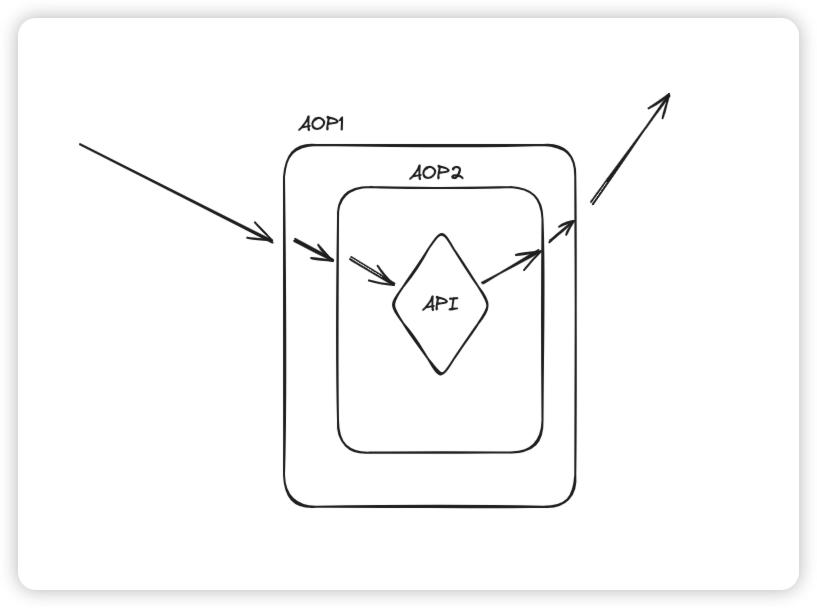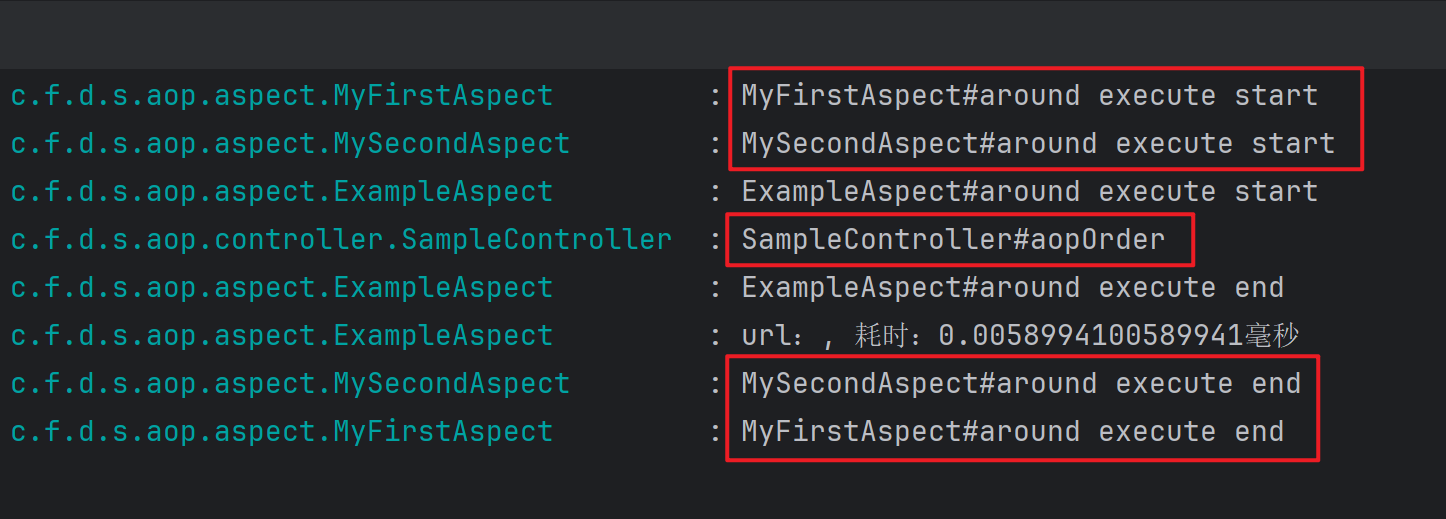Spring Boot Aop 执行顺序
1. 概述
在 spring boot 项目中,使用 aop 增强,不仅可以很优雅地扩展功能,还可以让一写多用,避免写重复代码,例如:记录接口耗时,记录接口日志,接口权限,等等。所以,在项目中学习并使用 aop ,是十分必要的。然而,当我们在一个接口中使用多个 aop,时,就需要注意他们的执行顺序了。那么,它们的执行顺序是怎样的呢?如果不把这个问题搞明白,那我们的程序就不可控,这是不允许的,这就是我们今天要讨论的问题。
2. 实现 AOP
2.1 通过注解实现 AOP
MyAop:
@Target({ElementType.METHOD})
@Retention(RetentionPolicy.RUNTIME)
public @interface MyAop {
}
MyAspect:
@Aspect
@Component
public class MyAspect {
@Around("@annotation(aop)")
public Object around(ProceedingJoinPoint joinPoint,
MyAop aop) throws Throwable {
return joinPoint.proceed();
}
}
SampleController#myApi:
@RestController
@RequestMapping("/sample")
public class SampleController {
@MyAop
@RequestMapping("/my-api")
public String myApi() {
return "success";
}
}
这样,我们就通过使用注解的方式实现了 AOP 。
2.2 通过扫描包
比如,我们有这样一个接口 SampleController#myApi2:
@RestController
@RequestMapping("/sample")
public class SampleController {
@RequestMapping("/my-api2")
public String myApi2() {
return "success";
}
}
我们可以使用包扫描的方式进行拦截:
@Aspect
@Component
public class My2Aspect {
@Around("execution(* com.fengwenyi.demo.springboot.aop.controller.SampleController.myApi2(..))")
public Object around(ProceedingJoinPoint joinPoint) throws Throwable {
return joinPoint.proceed();
}
}
这样,我们也就通过使用包扫描的方式实现了 AOP 。
3. 多个 AOP
3.1 分析
先提一个疑问:多个AOP注解,执行顺序是怎么样的呢?如何设置执行顺序呢?
比如,APP 请求我们的 API 接口,在请求到达 API 接口之前,可以先执行 AOP1,在执行 AOP2,并且顺序不能变,如下图:

我们再拆解一下实际内部执行逻辑。
请求:请求先进入到 AOP1,再进入到 AOP2,最后到达 API。
返回:执行完 API,再回到 AOP2,最后回到 AOP1。
如下图:

因为我们用的是 Around,先进入Aop1,再进入到aop2,然后执行api,执行完以后,再返回到 aop2,最后返回aop1。
3.2 代码实现
MyFirstAop:
@Target({ElementType.METHOD})
@Retention(RetentionPolicy.RUNTIME)
public @interface MyFirstAop {
}
MyFirstAspect:
@Slf4j
@Aspect
@Component
@Order(100002)
public class MyFirstAspect {
@Around("@annotation(aop)")
public Object around(ProceedingJoinPoint joinPoint,
MyFirstAop aop) throws Throwable {
log.info("MyFirstAspect#around execute start");
try {
return joinPoint.proceed();
} finally {
log.info("MyFirstAspect#around execute end");
}
}
}
MySecondAop:
@Target({ElementType.METHOD})
@Retention(RetentionPolicy.RUNTIME)
public @interface MySecondAop {
}
MySecondAspect:
@Slf4j
@Aspect
@Component
@Order(100003)
public class MySecondAspect {
@Around("@annotation(aop)")
public Object around(ProceedingJoinPoint joinPoint,
MySecondAop aop) throws Throwable {
log.info("MySecondAspect#around execute start");
try {
return joinPoint.proceed();
} finally {
log.info("MySecondAspect#around execute end");
}
}
}
SampleController#aopOrder:
@RestController
@RequestMapping("/sample")
public class SampleController {
@MySecondAop
@MyFirstAop
@RequestMapping("/aop-order")
public String aopOrder() {
return "aopOrder";
}
}
 image-20240119075507098
image-20240119075507098通过设定 Order 值,指定 AOP 执行顺序,与我们的期望一致。
好了,今天的分享就到这里了,源码:demo-spring-boot-aop。
共同学习,写下你的评论
评论加载中...
作者其他优质文章





